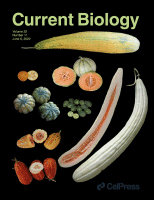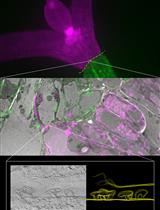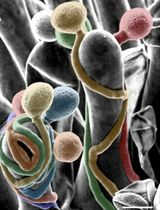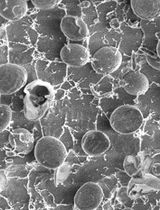- EN - English
- CN - 中文
Focused Ion Beam Milling and Cryo-electron Tomography Methods to Study the Structure of the Primary Cell Wall in Allium cepa
用聚焦离子束铣削和低温电子断层扫描术方法研究洋葱原代细胞壁的结构
发布: 2022年12月05日第12卷第23期 DOI: 10.21769/BioProtoc.4559 浏览次数: 2475
评审: Shyam SolankiAnonymous reviewer(s)
Abstract
Cryo-electron tomography (cryo-ET) is a formidable technique to observe the inner workings of vitrified cells at a nanometric resolution in near-native conditions and in three-dimensions. One consequent drawback of this technique is the sample thickness, for two reasons: i) achieving proper vitrification of the sample gets increasingly difficult with sample thickness, and ii) cryo-ET relies on transmission electron microscopy (TEM), requiring thin samples for proper electron transmittance (<500 nm). For samples exceeding this thickness limit, thinning methods can be used to render the sample amenable for cryo-ET. Cryo-focused ion beam (cryo-FIB) milling is one of them and despite having hugely benefitted the fields of animal cell biology, virology, microbiology, and even crystallography, plant cells are still virtually unexplored by cryo-ET, in particular because they are generally orders of magnitude bigger than bacteria, viruses, or animal cells (at least 10 μm thick) and difficult to process by cryo-FIB milling. Here, we detail a preparation method where abaxial epidermal onion cell wall peels are separated from the epidermal cells and subsequently plunge frozen, cryo-FIB milled, and screened by cryo-ET in order to acquire high resolution tomographic data for analyzing the organization of the cell wall.
Keywords: FIB-milling (聚焦离子束铣削)Background
Cryo-electron tomography (cryo-ET) relies on the ability to observe a thin vitrified or cryo-immobilized sample. Vitrified water is a metastable state of water achieved when the freezing rate is high enough that the water molecules do not have time to reorganize in a hexagonal lattice crystal (Dubochet, 2007). This state of water, also called amorphous ice, can also withstand the vacuum of the cryo-electron microscope (cryo-EM). In turn, the sample is observed in a near-native state, as all cellular processes were immobilized at freezing time. At ambient pressure, vitrification is achieved by plunge freezing the sample in liquid propane, ethane, or a mix of both. The freezing rates achievable with these cryogens at ambient pressure limit vitrification thickness to approximately 10 μm. After proper vitrification, samples that exceed 500 nm in thickness need to be thinned down. The go-to method nowadays is cryo-focused ion beam (cryo-FIB) milling (Villa et al., 2013). Originally used in the material science field, this technique uses a focused gallium beam to erode the sample away and create thin lamellae, approximately 200 nm thick, amenable to cryo-ET.
Onion epidermal cell wall peels have been used in atomic force microscopy (AFM) studies to study the arrangement of the cellulose fibers in the superficial inner layers of the cell wall (Kafle et al., 2013; T. Zhang et al., 2014, 2017). They are a model for the structural and mechanical study of the primary cell wall (Y. Zhang et al., 2021). Despite being a high-resolution imaging method allowing observations in the native state, AFM can only image the few superficial layers of the cell wall. These cell wall peels happen to be between 5 and 10 μm in thickness, which is compatible with plunge freezing but still too thick for direct imaging by cryo-EM. Performing cryo-FIB milling on the cell wall peels allow i) screening and tilt series acquisition by cryo-ET, and ii) access to the deeper layers of the cell wall, previously unattainable by AFM. This protocol describes the sample preparation, data acquisition, and processing involved in our study called “Cryo-electron tomography of the onion cell wall shows bimodally oriented cellulose fibers and reticulated homogalacturonan networks” (Nicolas et al., 2022). We are confident that this system, in conjunction with cryo-ET and cryo-FIB milling, can become a powerful method to study the effects of mechanical stress and various treatments on the cell wall, while allowing a better understanding of the interaction of the different components present in the cell wall and their mechanical impact there.
Materials and Reagents
Plant material
Plastic Petri dishes (RPI, catalog number: 160265)
Sharp knife
Double edge razor blades (EMS, catalog number: 72002-01)
Glass slides (EMS, catalog number: 71863-01)
Cover slips (VWR, catalog number: 48366-067)
Fresh white onions from the local supermarket (see Note 1)
HEPES powder (RPI, catalog number: H75030-50.0)
CAPS powder (Sigma, catalog number: C2632-100G)
KOH powder (Sigma, catalog number 06103-1KG)
Tween-20 (RPI, catalog number: P20370-0.5)
Deionized (DI) water
BAPTA (Sigma-Aldrich, catalog number: C2632-100)
Pectate lyase from Aspergillus (Megazyme, catalog number: E-PCLYAN2)
NaOH powder (Sigma, catalog number RDD007-1KG)
HEPES 20 mM buffer solution (see Recipes)
CAPS 50 mM buffer solution (see Recipes)
Pectate lyase at 4.7 U/mL (5 mL) (see Recipes)
BAPTA 2 mM (see Recipes)
Plunge freezing
Glass slides (EMS, catalog number: 71863-01)
Grid boxes (Thermo Fisher) (see Note 2)
London Finder Quantifoil grids NH2 R2/2 copper 200 mesh (EMS #LFH2100CR2) (see Note 3)
Cut up blotting pads (Whatman, catalog number: 1540-055)
Liquid nitrogen
Liquid ethane/propane (60/40 ratio)
Ethanol 70%
Grid clipping
FIB autogrids (Thermo Fisher, catalog number: 1205101)
C-rings (Thermo Fisher)
Magnifying lens (Intertek LTS-F21-61)
Clipping pens (Thermo Fisher)
Sharpie pen (red or black)
Autogrid grid boxes (Thermo Fisher)
Lid pen (Thermo Fisher)
Cryo-FIB milling
Liquid nitrogen
Argon gas
Shuttle (Quorum Tech, catalog number: 12406)
Cryo-ET screening and tilt-series acquisition
Grid cassette (Thermo Fisher)
NanoCab (Thermo Fisher)
Equipment
Plant material
Any light microscope equipped with phase contrast
Plunge freezing
EMS tweezers (EMS style 2, 5, 3X, and 7)
Vitrobot tweezers (Inox-Medical LS 11253-27)
Flexible LED lamp
Large forceps and small rubber band (EMS style 7330)
Vitrobot Mark II (Thermo Fisher)
Glow discharger (EMS 100X, not sold anymore; alternatively, Pelco easyGlow)
Liquid nitrogen storage system (Worthington HC35)
LN2 containers (spearlab.com)
Grid clipping
Autogrid tweezers (PELCO 5046-SV)
Clipping station (Thermo Fisher)
Cryo-FIB milling
Versa 3D DualBeam FIB-SEM (FEI)
Quorum PP3000T transfer system (Quorum Tech)
Cryo-ET screening and tilt series acquisition
Titan Krios 300 kV microscope (Thermo Fisher)
Gatan K3 direct director (Gatan)
Post-column GIF energy filter (Thermo Fisher)
Software
SerialEM (https://bio3d.colorado.edu/) (Mastronarde, 2003, 2005), to control the TEM
Gatan DM3 (https://www.gatan.com/products/tem-analysis/gatan-microscopy-suite-software), to control the K3 detector
Etomo (https://bio3d.colorado.edu/imod/download.html) for tomogram reconstruction and 3dmod for tomogram visualization (Kremer et al., 1996; Mastronarde, 1997; Mastronarde and Held, 2017)
EMAN2 (https://blake.bcm.edu/emanwiki/EMAN2) for Convolutional Neural Network (CNN) training and application (Chen et al., 2017; Tang et al., 2007, p. 2), Amira and the Xtracing plugin (Thermo Fisher) (https://www.thermofisher.com/us/en/home/electron-microscopy/products/software-em-3d-vis/amira-software.html) for segmentation (Rigort et al., 2012)
ARETOMO for automated alignment and reconstruction (https://msg.ucsf.edu/software)
Custom scripts derived from Dimchev et al. (2021)
R and R studio to analyze the data (https://cran.r-project.org/index.html, https://www.rstudio.com/)
Procedure
文章信息
版权信息
© 2022 The Authors; exclusive licensee Bio-protocol LLC.
如何引用
Nicolas, W. J., Jensen, G. J. and Meyerowitz, E. M. (2022). Focused Ion Beam Milling and Cryo-electron Tomography Methods to Study the Structure of the Primary Cell Wall in Allium cepa. Bio-protocol 12(23): e4559. DOI: 10.21769/BioProtoc.4559.
分类
植物科学 > 植物细胞生物学 > 细胞壁
细胞生物学 > 细胞成像 > 电子显微镜
生物物理学 > 电子冷冻断层扫描
您对这篇实验方法有问题吗?
在此处发布您的问题,我们将邀请本文作者来回答。同时,我们会将您的问题发布到Bio-protocol Exchange,以便寻求社区成员的帮助。
Share
Bluesky
X
Copy link














